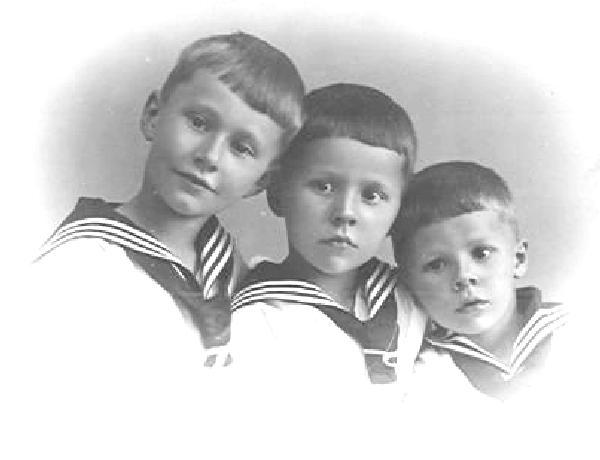
German Fashion Industry: Influence

Figure 1.--The sailor suit in the 20th century was more popular in Germany than virtually any other country. Certainly it was more popular than in Britain where it originated. We bekieve that Germany helped to populasrize he sailor suit in Central and Eastern Eyrope.
|
France is the country most associated with fashion. Paris and London were perhaps the two most important centers of the fashion industry in Europe. French fashion has been especially important in women's fashions. Britain has been an important influence in men and boys fashion. Berlin and Vienna were in the early 20th century before World War II also of considerable prominance. We are not sure just what fashion sectors were involved. Here we are primarily concerned with boys' fashions. We see a German fashion influence in both central and Eastern Europe as well as Scandinavia. There are a number of reasons for this. One are the historical ties. Czechoslovakia and Hungary as well as parts of Yugoslavia and Poland were part of the Austro-Hungarian Empire. Areas of Poland were part of the German Empire. Two was the size of the German economy. Even after World war I, the German economy was an economic powerhouse which dominated the economies of Central and Wetern Europe as well as Scandinavia. Three was royal families. Several countries had German royal families. .
Germany and Austria
France is the country most associated with fashion. Paris and London were perhaps the two most important centers of the fashion industry in Europe. French fashion has been especially important in women's fashions. Britain has been an important influence in men and boys fashion. Berlin and Vienna were in the early 20th century before World War II also of considerable prominance. We are not sure just what fashion sectors were involved. Here we are primarily concerned with boys' fashions. We see a German fashion influence in both central and Eastern Europe as well as Scandinavia.
Reasons for German Prominance
There are a number of reasons for the importance of the German Fashion industry.
Historical Ties
One ingluence was historical ties. Czechoslovakia and Hungary as well as parts of Yugoslavia and Poland were part of the Austro-Hungarian Empire. Areas of Poland were part of the German Empire. The fact that the ruling class was German or Austrian and the economic exchanges followed political ties were all important factors.
German economy
Another influence was the size of the German economy. Even after World war I, the German economy was an economic powerhouse which dominated the economies of Central and Wetern Europe as well as Scandinavia. The German fashion influence can be seen in the same way as the British impct within the British Empire and the American fashion influence, especiallu after World War II.
World War I
A Canadian reader believes that World War I was a factor. He writes, "There are many reasons why German clothings were spreading not only
around Germany but also in North America and mainly in Quebec. After
World War I, Germany was exactly what became Japan after World War II. Good products at a lower price. There was a lot of ships from Germany caming in Montreal which was the door of the continent for overseas ships. My father who was a pilot on the St-Lawrence River noted that German trading outpassed British in 1930." HBC has no information about this time about German sales to the United States. Our reader's comments about sale to Canada is interesting.
Royal families
A third factor were was royal families. Bulgaria, Greece, and Romania had German royal families. It is difficult to assess the fashion impact of these foreign royal families. It seems likely that they did affect styles worn by the middle and upper classes. The sailor suit may in particularly a style popularized by these royal families.
Questions
We have just begun to assess the German fashion and its influence. One HBC reader suggests that we may be over emphasizing the German influence. Our reader writes, "I think it's wrong to tie it too much to German influence. The style was popular not only in Central Europe but throughout Eastern Europe. I've seen them from Finland to Georgia, including many places not exactly sympathetic to Germans. I think that the idea of that kind of suspension had spread far (from wherever it originated), and by the 20th century it had no national connotations in the minds of moms. It had become part of the folk culture." Our reader makes several important points. We should not, howver, fashion influences with political sympayhies. We note, for instance, findamentalist terrorists in the arab world wearing jean and sneakers.
Decline of the German Fashion Influence
We notethat after World war II a rapid decline of the German fashion influence. There are several factors here. One the Germans were so hated throughout Europe that any style associayed with Germany was prejected. Two the strategic bombing campaign destroyed plants throughout Germany. Thus Germany was not producing clohes of ny kind which could be imported. Three was that Jews were a vital part of the German fashion influence. The NAZIs forced the Jews out of the fashion and other industries in the 1930s. This damaged the industry affecting both its creative spirit and management.
HBC

Navigate the Boys' Historical Clothing German pages:
[Rerurn to the Main German fashion industry page]
[German choirs]
[German movies]
[German school uniforms]
[German royalty]
[German youth groups]
[German sailor suits]
[Lederhosen]
[Ethnic]
[Tights]
[Long stockings]
Navigate the Boys' Historical Clothing Web Site:
[Introduction]
[Activities]
[Bibliographies]
[Biographies]
[Chronology]
[Clothing styles]
[Countries]
[Contributions]
[FAQs]
[German glossaries]
[Satellite sites]
[Tools]
[Boys' Clothing Home]
Created: 8:42 PM 4/27/2005
Last updated: 8:42 PM 4/27/2005



